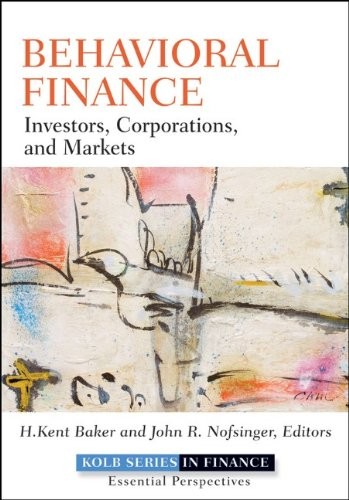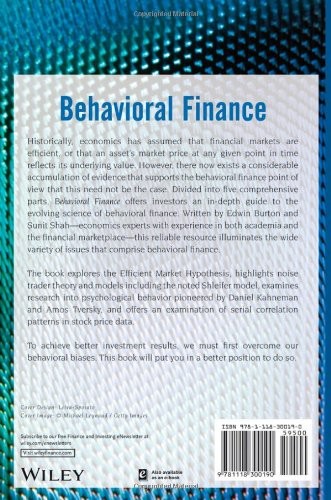Inefficient Markets An Introduction to Behavioral Finance Clarendon Lectures in Economics Andrei
Post on: 16 Март, 2015 No Comment

The efficient markets hypothesis has been the central proposition in finance for nearly thirty years. It states that securities prices in financial markets must equal fundamental values, either because all investors are rational or because arbitrage eliminates pricing anomalies.
Los clientes que compraron este producto también compraron
Android
Opiniones de clientes más útiles en Amazon.com (beta)
191 de 200 personas piensan que la opinión es útil
Fabulous Book! 28 de marzo de 2000
Por Vincent E. Vizachero — Publicado en Amazon.com
Formato: Tapa dura
Inefficient Markets is the most thoughtful original treatment of behavioral finance I have found. Unlike most other books on this topic, which either are vapidly light but original or are intellectually rewarding but disjointed compendiums of previously published articles, Shleifer has produced an interesting and intelligent synthesis of behavioral finance. He organizes his materially logically and clearly, covering the central themes of behavioral finance in as unified a manner as the subject permits. He has clearly thought hard about the subject matter, and his book reflects this. Shleifer’s writing style is both lucid and academically rigorous, which makes for an enjoyable and informative book.
Shleifer begins by reviewing the theoretical and empirical foundations of the efficient market hypothesis (EMH) and introducing the principal challenges to this hypothesis. His review of the EMH is careful, objective, and respectful. His introduction to the principal challenges to the EMH is written with equal integrity, and his analysis of these challenges is non-dogmatic and relatively conservative. He carefully avoids overstating the conclusions of the academic research. While Shleifer clearly feels that financial markets are NOT efficient, as an academic he also acknowledges the inability of empirical research to PROVE with certainty that financial markets are or are not efficient. It is his careful interpretation of the evidence on both sides of the EMH fence that gives this book its tremendous credibility.
The majority of Inefficient Markets covers the two principal building blocks of behavioral finance: the theory of limited arbitrage and the theory of investor sentiment. Shleifer demonstrates that arbitrage is of limited usefulness in relatively competitive markets, much less in more complicated environments, and that financial markets should not be presumed efficient. He then presents a model of investor sentiment that incorporates the results of experimental research into individual decision-making under conditions of uncertainty. Shleifer also provides an extremely clear overview of the DeLong et al. noise trader model, and concludes the book by highlighting some of the unsolved problems in financial economics.
It should be noted, if it is not already clear, that this book is intended for PhD and advanced MBA students (in fact, the book is a core text for the University of Chicago’s PhD course in Behavioral Finance). The analysis in the book is both theoretical and rigorous. Nonetheless, the intellectually curious reader with a basic exposure to microeconomics and/or financial economics will find the book rewarding. You are guaranteed to come away from this book knowing more about that opportunities and challenges facing the field of behavioral finance.
For practitioners, or anyone looking for a more general/popular treatment of behavioral finance, I recommend Beyond Greed and Fear by Hersh Shefrin.
156 de 170 personas piensan que la opinión es útil
Only an introduction to Schleifer’s work 21 de agosto de 2000
Por Fred Roseblatt — Publicado en Amazon.com
Formato: Tapa dura
In this book, Professor Schleifer has collected some of his older papers, and given this collection a fashionable title, by making references both to market inefficiency and behavioral finance.
The truth is that these references don’t make too much sense, since he neither gives an introduction to behavioral finance (the study of how people make decisions under financial uncertainty), nor does he provide the reader with convincing arguments on why markets are inefficient.
In chapter 2, he introduces the noise trader hypothesis, based on an article he wrote in the Journal of Finace (JOF) in 1990. The problem with the noise trader hypothesis is that it is hardly a behavioral assumption; specifically it does not explain why people make a biased decision when faced with financial uncertainty. Moreover, the noise trader hypothesis is untestable. In the end, it is just an easy way of getting around some of the existing paradoxes in finance, by assuming that people are stupid — say noisy, in Schleifer’s vocabulary.
In chapter 4, he is concerned with the ‘limits of arbitrage’ (the original title of this paper, published in the JOF in 1997). This paper is definitely worth reading to understand the problems with hedge funds and other arbitrageurs. However, linking the limits of arbitrageurs to ‘inefficiency of the market’ is erroneous. The very fact that arbitrageurs can not take advantage of what they think are mispriced assets, due to collateral constraints (Schleifer’s hypothesis), shows that the market is efficient, since no free money is floating around.
The other chapters can be criticized in similar ways. E.g. chapter 3 on closed end funds has been criticized by his peers (Merton Miller, a.o.) in the JOF of 1993.
Nevertheless, this book is worth reading, since most of the articles Schleifer has written have been influential, placed in their proper context. However, anybody who thinks that he’s getting a good introduction to either inefficient market theory or behavioral finance, will feel deceived at the end of this book.
56 de 58 personas piensan que la opinión es útil
chapter by chapter critique 23 de octubre de 2001

Por Eric Falkenstein — Publicado en Amazon.com
Formato: Tapa dura
Chapter 1 lays out the two pillars to his argument: a theory of investor sentiment, and limits to arbitrage. Both are needed, as without systematic deviations from rationality, irrational decisions cancel each other out, making them somewhat uninteresting (excepting increasing volume); without limits to arbitrage such irrational deviations from `true value’ are instantly poached by savvy rational investors.
The first model shows that if arbitrage is limited and noise traders have systematic biases, prices can deviate from fundamental value (DeLong et al, 1990a). That is, Shell can deviate from its fundamental value because no one has enough money and time to put the price into equilibrium, and investor sentiment varies between markets and over time. This model also has the interesting implication that less informed investors might earn a higher rate of return on their total portfolios because they irrationally believe they have a more favorable risk-return opportunity and hence invest in securities with a higher return. In effect, their stupidity effectively diminishes their risk aversion, and in the long run allows a lucky few of them to reap the financial rewards that would accrue to the less risk averse (one could call it the `Forrest Gump’ effect). As opposed to speculation weeding out the irrational traders and making only the best opinions matter, the irrational can dominate.
The closed fund puzzle is presented in chapter three and highlights some of the problems of this approach (Lee, Thaler and Shleifer, 1991). The issue to be explained is why 1) funds are issued at premiums to net asset value (overpriced) and 2) funds eventually trade at discount to net asset value (underpriced). While the underpricing is addressed through the mechanism outlined in the first model (limited arbitrage and noise traders), the overpricing effect is addressed by assuming that `noise traders’ buy up the initial issuance-not very subtle. Clearly if noise traders can be foisted into overpaying or underpaying within models by assumption, it is hard to avoid the inference that this approach can explain everything and thus nothing.
Of course on occasion EMH proponents also try to explain seemingly everything, where exceptions are assumed order-statistics until they are granted statistical significance, at which time they are instantly seen as an efficient proxy of unmeasured risk (e.g. the value and size effect). Yet explanatory greediness is clearly more of a problem to the inefficient markets camp. For example, in addition to the above example, investor sentiment is used to explain both the equity-premium puzzle (i.e. why stock prices are too low on average) and why recent p/e multiples are too high (page 180): if the equity-premium is a `puzzle’ it is difficult to also say that our currently historically high p/e multiple is irrational, but if the p/e ratio `should’ be lower (around 15) then the equity premium is not a puzzle.
In chapter 4 a nice approach is taken towards professional arbitrage (Shleifer and Vishny, 1997). By modeling it as a principal agent problem, this model captures some relevant issues usually addressed by the Industrial Organization literature. Clearly there is relevance to modeling the situation where hedge fund managers have uncertain skill and investors have to evaluate them. The failure of famed hedge fund LTCM in 1998 was defended, like almost all bankruptcies, as a failure of investor’s patience—outsiders are always much quicker at pulling the plug than insiders would prefer. Modeling, in this case, a liquidity constraint, is a highly relevant issue that seems well suited for asymmetric information and principal-agent modeling.
Chapter 5 introduces the model of investor sentiment, that is, why we should expect noise traders to vary systematically in their buy or sell orders (Barberis, Shleifer, and Vishny, 1998). It derives a straightforward and testable hypothesis based on Bayesian updating of a regime-switching model. For earnings or other surprises that continue a trend, overreaction is predicted, for surprises that counter a trend, underreaction is predicted.
In chapter 6, we see the DeLong, Shleifer, Summers, and Waldeman series on noise traders and positive feedback loops (DSSW, 1990b). This sort of model bothers me because it is a bit disingenuous. It puts superficial rigor onto to the simple idea that given constraints on arbitrage, irrational trend-following investors can make it rational to follow trends, and thus rational traders can be destabilizing. It is not a compelling model because the results are not derived inevitably and subtly from general assumptions and a friction, but instead from assumptions which guarantee the result (e.g. trend-following noise traders and limited arbitrage). Is it at all helpful to take a straightforward idea that can be clearly expressed in a sentence and model this with contrived algebra? Personally I do not think so, though the realist in me understands that without a model to point to, the idea would not be taken as seriously as it has.
It is stressed throughout the book that risky arbitrage makes taking advantage of pervasive irrationality difficult. Yet if irrationality is a systemic and pervasive phenomenon, then there exist hundreds of scenarios like mispriced Shell, overvalued Amazon, undepriced closed funds, overvalued currencies, overvalued IPOs, etc. Surely over several years these positions, somewhat independent, should make significant abnormal risk-adjusted returns. As is more probable, there are not hundreds of such situations, but perhaps a handful, and with the rational markets assumption ignored hundreds more opportunities appear to exist but actually do not (e.g. the small firm effect). Be sure to monitor Thaler’s funds (UBRLX and UBVLX) and Sheifer’s fund (LSVEX).
24 de 29 personas piensan que la opinión es útil
Necessary Book for Finance 25 de diciembre de 2000
Por W. James D. Easton — Publicado en Amazon.com














